Epidemiological Analysis of HIV Prevalence in Hackney Region
VerifiedAdded on 2020/02/05
|13
|3676
|133
Report
AI Summary
This report investigates the epidemiology of HIV prevalence in the Hackney region of London. It begins by defining epidemiology and HIV/AIDS, discussing HIV types, symptoms, and global statistics. The report then profiles the Hackney community, highlighting its demographics, HIV prevalence rates, and at-risk populations. It explores epidemiological methods used to study HIV, including national surveys, antenatal clinical surveys, and studies of high-risk populations, as well as observational studies like cohort and cross-sectional studies. Finally, the report examines interventions implemented in Hackney to reduce HIV prevalence, such as free condom distribution, free HIV testing, and combination prevention strategies involving biomedical, behavioral, and structural interventions. The report emphasizes the need for increased awareness, public health initiatives, and continued efforts to combat HIV/AIDS in the region.

EPIDEMIOLOGY OF HIV PREVALENCE IN HACKNEY 1
Epidemiology of HIV prevalence in Hackney
Student's Name:
Instructor's Name:
Date:
Epidemiology of HIV prevalence in Hackney
Student's Name:
Instructor's Name:
Date:
Paraphrase This Document
Need a fresh take? Get an instant paraphrase of this document with our AI Paraphraser
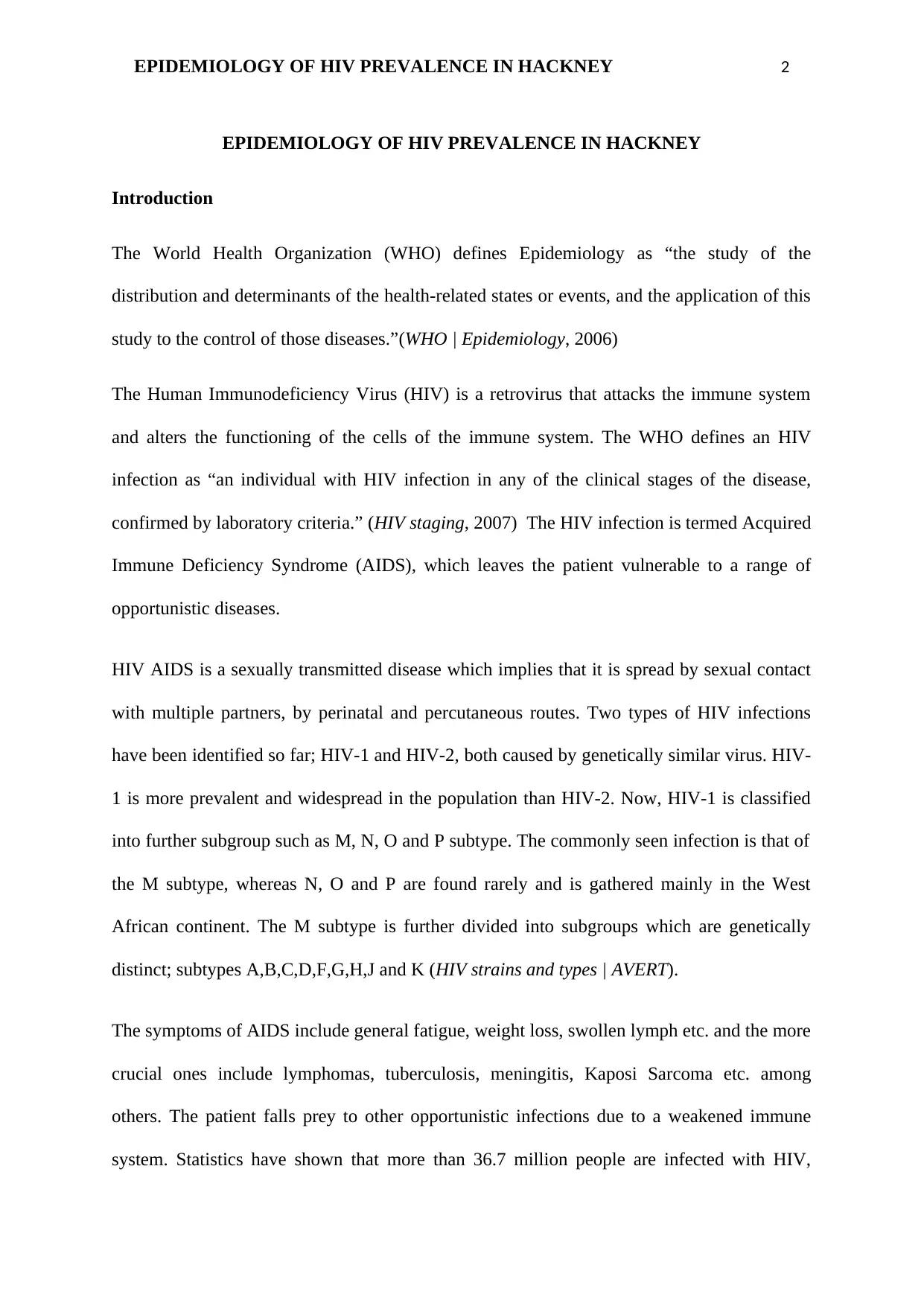
EPIDEMIOLOGY OF HIV PREVALENCE IN HACKNEY 2
EPIDEMIOLOGY OF HIV PREVALENCE IN HACKNEY
Introduction
The World Health Organization (WHO) defines Epidemiology as “the study of the
distribution and determinants of the health-related states or events, and the application of this
study to the control of those diseases.”(WHO | Epidemiology, 2006)
The Human Immunodeficiency Virus (HIV) is a retrovirus that attacks the immune system
and alters the functioning of the cells of the immune system. The WHO defines an HIV
infection as “an individual with HIV infection in any of the clinical stages of the disease,
confirmed by laboratory criteria.” (HIV staging, 2007) The HIV infection is termed Acquired
Immune Deficiency Syndrome (AIDS), which leaves the patient vulnerable to a range of
opportunistic diseases.
HIV AIDS is a sexually transmitted disease which implies that it is spread by sexual contact
with multiple partners, by perinatal and percutaneous routes. Two types of HIV infections
have been identified so far; HIV-1 and HIV-2, both caused by genetically similar virus. HIV-
1 is more prevalent and widespread in the population than HIV-2. Now, HIV-1 is classified
into further subgroup such as M, N, O and P subtype. The commonly seen infection is that of
the M subtype, whereas N, O and P are found rarely and is gathered mainly in the West
African continent. The M subtype is further divided into subgroups which are genetically
distinct; subtypes A,B,C,D,F,G,H,J and K (HIV strains and types | AVERT).
The symptoms of AIDS include general fatigue, weight loss, swollen lymph etc. and the more
crucial ones include lymphomas, tuberculosis, meningitis, Kaposi Sarcoma etc. among
others. The patient falls prey to other opportunistic infections due to a weakened immune
system. Statistics have shown that more than 36.7 million people are infected with HIV,
EPIDEMIOLOGY OF HIV PREVALENCE IN HACKNEY
Introduction
The World Health Organization (WHO) defines Epidemiology as “the study of the
distribution and determinants of the health-related states or events, and the application of this
study to the control of those diseases.”(WHO | Epidemiology, 2006)
The Human Immunodeficiency Virus (HIV) is a retrovirus that attacks the immune system
and alters the functioning of the cells of the immune system. The WHO defines an HIV
infection as “an individual with HIV infection in any of the clinical stages of the disease,
confirmed by laboratory criteria.” (HIV staging, 2007) The HIV infection is termed Acquired
Immune Deficiency Syndrome (AIDS), which leaves the patient vulnerable to a range of
opportunistic diseases.
HIV AIDS is a sexually transmitted disease which implies that it is spread by sexual contact
with multiple partners, by perinatal and percutaneous routes. Two types of HIV infections
have been identified so far; HIV-1 and HIV-2, both caused by genetically similar virus. HIV-
1 is more prevalent and widespread in the population than HIV-2. Now, HIV-1 is classified
into further subgroup such as M, N, O and P subtype. The commonly seen infection is that of
the M subtype, whereas N, O and P are found rarely and is gathered mainly in the West
African continent. The M subtype is further divided into subgroups which are genetically
distinct; subtypes A,B,C,D,F,G,H,J and K (HIV strains and types | AVERT).
The symptoms of AIDS include general fatigue, weight loss, swollen lymph etc. and the more
crucial ones include lymphomas, tuberculosis, meningitis, Kaposi Sarcoma etc. among
others. The patient falls prey to other opportunistic infections due to a weakened immune
system. Statistics have shown that more than 36.7 million people are infected with HIV,
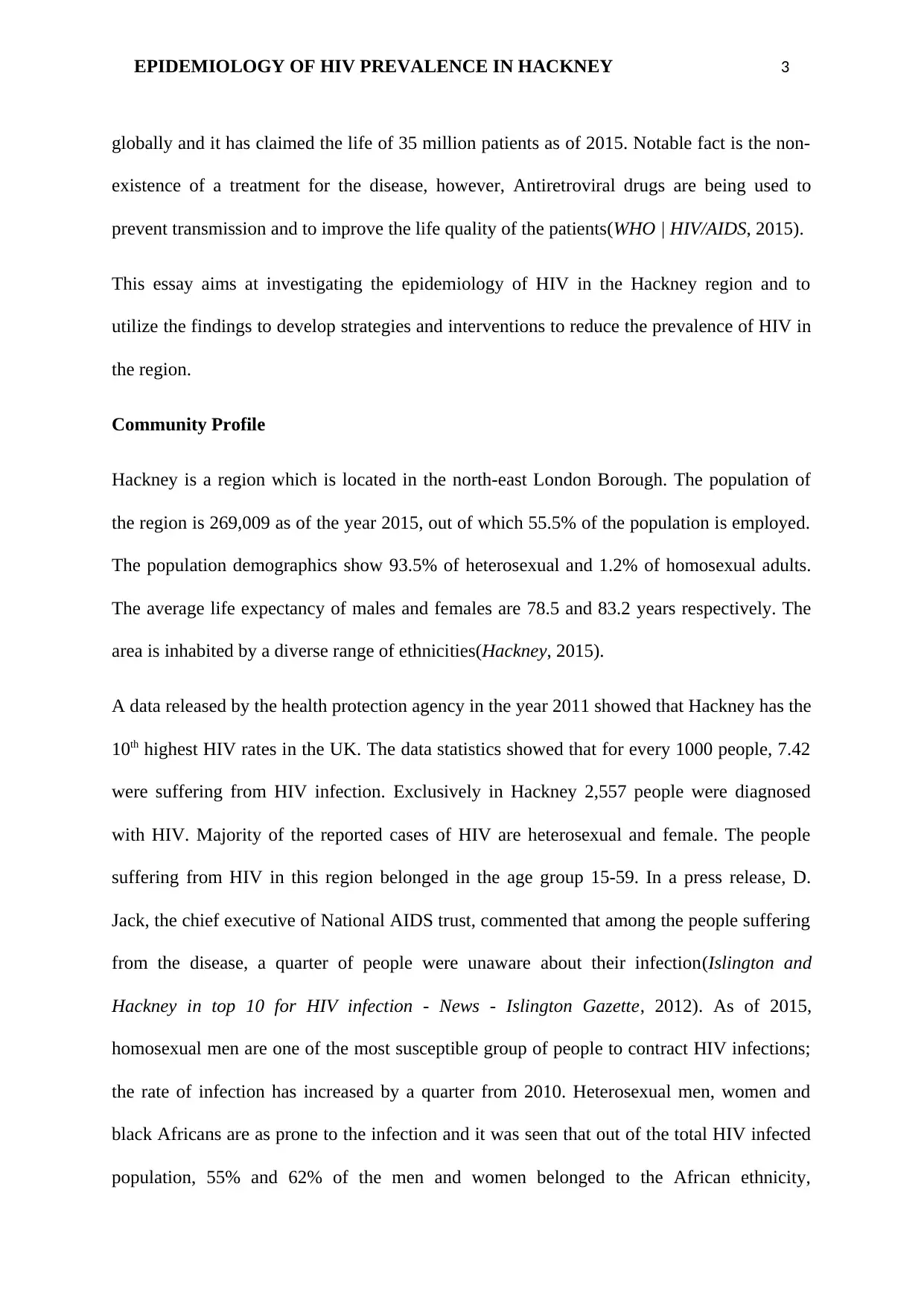
EPIDEMIOLOGY OF HIV PREVALENCE IN HACKNEY 3
globally and it has claimed the life of 35 million patients as of 2015. Notable fact is the non-
existence of a treatment for the disease, however, Antiretroviral drugs are being used to
prevent transmission and to improve the life quality of the patients(WHO | HIV/AIDS, 2015).
This essay aims at investigating the epidemiology of HIV in the Hackney region and to
utilize the findings to develop strategies and interventions to reduce the prevalence of HIV in
the region.
Community Profile
Hackney is a region which is located in the north-east London Borough. The population of
the region is 269,009 as of the year 2015, out of which 55.5% of the population is employed.
The population demographics show 93.5% of heterosexual and 1.2% of homosexual adults.
The average life expectancy of males and females are 78.5 and 83.2 years respectively. The
area is inhabited by a diverse range of ethnicities(Hackney, 2015).
A data released by the health protection agency in the year 2011 showed that Hackney has the
10th highest HIV rates in the UK. The data statistics showed that for every 1000 people, 7.42
were suffering from HIV infection. Exclusively in Hackney 2,557 people were diagnosed
with HIV. Majority of the reported cases of HIV are heterosexual and female. The people
suffering from HIV in this region belonged in the age group 15-59. In a press release, D.
Jack, the chief executive of National AIDS trust, commented that among the people suffering
from the disease, a quarter of people were unaware about their infection(Islington and
Hackney in top 10 for HIV infection - News - Islington Gazette, 2012). As of 2015,
homosexual men are one of the most susceptible group of people to contract HIV infections;
the rate of infection has increased by a quarter from 2010. Heterosexual men, women and
black Africans are as prone to the infection and it was seen that out of the total HIV infected
population, 55% and 62% of the men and women belonged to the African ethnicity,
globally and it has claimed the life of 35 million patients as of 2015. Notable fact is the non-
existence of a treatment for the disease, however, Antiretroviral drugs are being used to
prevent transmission and to improve the life quality of the patients(WHO | HIV/AIDS, 2015).
This essay aims at investigating the epidemiology of HIV in the Hackney region and to
utilize the findings to develop strategies and interventions to reduce the prevalence of HIV in
the region.
Community Profile
Hackney is a region which is located in the north-east London Borough. The population of
the region is 269,009 as of the year 2015, out of which 55.5% of the population is employed.
The population demographics show 93.5% of heterosexual and 1.2% of homosexual adults.
The average life expectancy of males and females are 78.5 and 83.2 years respectively. The
area is inhabited by a diverse range of ethnicities(Hackney, 2015).
A data released by the health protection agency in the year 2011 showed that Hackney has the
10th highest HIV rates in the UK. The data statistics showed that for every 1000 people, 7.42
were suffering from HIV infection. Exclusively in Hackney 2,557 people were diagnosed
with HIV. Majority of the reported cases of HIV are heterosexual and female. The people
suffering from HIV in this region belonged in the age group 15-59. In a press release, D.
Jack, the chief executive of National AIDS trust, commented that among the people suffering
from the disease, a quarter of people were unaware about their infection(Islington and
Hackney in top 10 for HIV infection - News - Islington Gazette, 2012). As of 2015,
homosexual men are one of the most susceptible group of people to contract HIV infections;
the rate of infection has increased by a quarter from 2010. Heterosexual men, women and
black Africans are as prone to the infection and it was seen that out of the total HIV infected
population, 55% and 62% of the men and women belonged to the African ethnicity,
⊘ This is a preview!⊘
Do you want full access?
Subscribe today to unlock all pages.

Trusted by 1+ million students worldwide
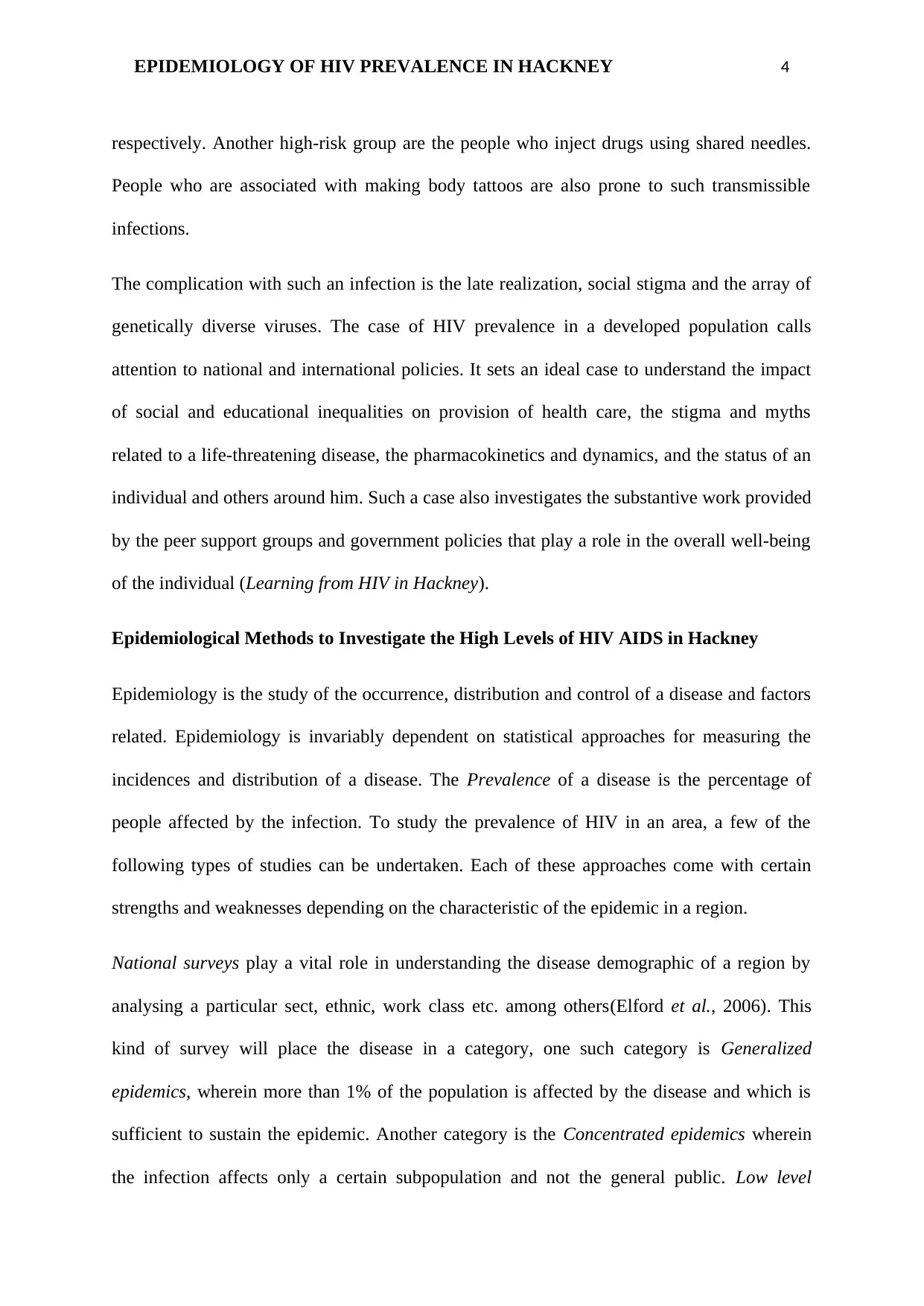
EPIDEMIOLOGY OF HIV PREVALENCE IN HACKNEY 4
respectively. Another high-risk group are the people who inject drugs using shared needles.
People who are associated with making body tattoos are also prone to such transmissible
infections.
The complication with such an infection is the late realization, social stigma and the array of
genetically diverse viruses. The case of HIV prevalence in a developed population calls
attention to national and international policies. It sets an ideal case to understand the impact
of social and educational inequalities on provision of health care, the stigma and myths
related to a life-threatening disease, the pharmacokinetics and dynamics, and the status of an
individual and others around him. Such a case also investigates the substantive work provided
by the peer support groups and government policies that play a role in the overall well-being
of the individual (Learning from HIV in Hackney).
Epidemiological Methods to Investigate the High Levels of HIV AIDS in Hackney
Epidemiology is the study of the occurrence, distribution and control of a disease and factors
related. Epidemiology is invariably dependent on statistical approaches for measuring the
incidences and distribution of a disease. The Prevalence of a disease is the percentage of
people affected by the infection. To study the prevalence of HIV in an area, a few of the
following types of studies can be undertaken. Each of these approaches come with certain
strengths and weaknesses depending on the characteristic of the epidemic in a region.
National surveys play a vital role in understanding the disease demographic of a region by
analysing a particular sect, ethnic, work class etc. among others(Elford et al., 2006). This
kind of survey will place the disease in a category, one such category is Generalized
epidemics, wherein more than 1% of the population is affected by the disease and which is
sufficient to sustain the epidemic. Another category is the Concentrated epidemics wherein
the infection affects only a certain subpopulation and not the general public. Low level
respectively. Another high-risk group are the people who inject drugs using shared needles.
People who are associated with making body tattoos are also prone to such transmissible
infections.
The complication with such an infection is the late realization, social stigma and the array of
genetically diverse viruses. The case of HIV prevalence in a developed population calls
attention to national and international policies. It sets an ideal case to understand the impact
of social and educational inequalities on provision of health care, the stigma and myths
related to a life-threatening disease, the pharmacokinetics and dynamics, and the status of an
individual and others around him. Such a case also investigates the substantive work provided
by the peer support groups and government policies that play a role in the overall well-being
of the individual (Learning from HIV in Hackney).
Epidemiological Methods to Investigate the High Levels of HIV AIDS in Hackney
Epidemiology is the study of the occurrence, distribution and control of a disease and factors
related. Epidemiology is invariably dependent on statistical approaches for measuring the
incidences and distribution of a disease. The Prevalence of a disease is the percentage of
people affected by the infection. To study the prevalence of HIV in an area, a few of the
following types of studies can be undertaken. Each of these approaches come with certain
strengths and weaknesses depending on the characteristic of the epidemic in a region.
National surveys play a vital role in understanding the disease demographic of a region by
analysing a particular sect, ethnic, work class etc. among others(Elford et al., 2006). This
kind of survey will place the disease in a category, one such category is Generalized
epidemics, wherein more than 1% of the population is affected by the disease and which is
sufficient to sustain the epidemic. Another category is the Concentrated epidemics wherein
the infection affects only a certain subpopulation and not the general public. Low level
Paraphrase This Document
Need a fresh take? Get an instant paraphrase of this document with our AI Paraphraser
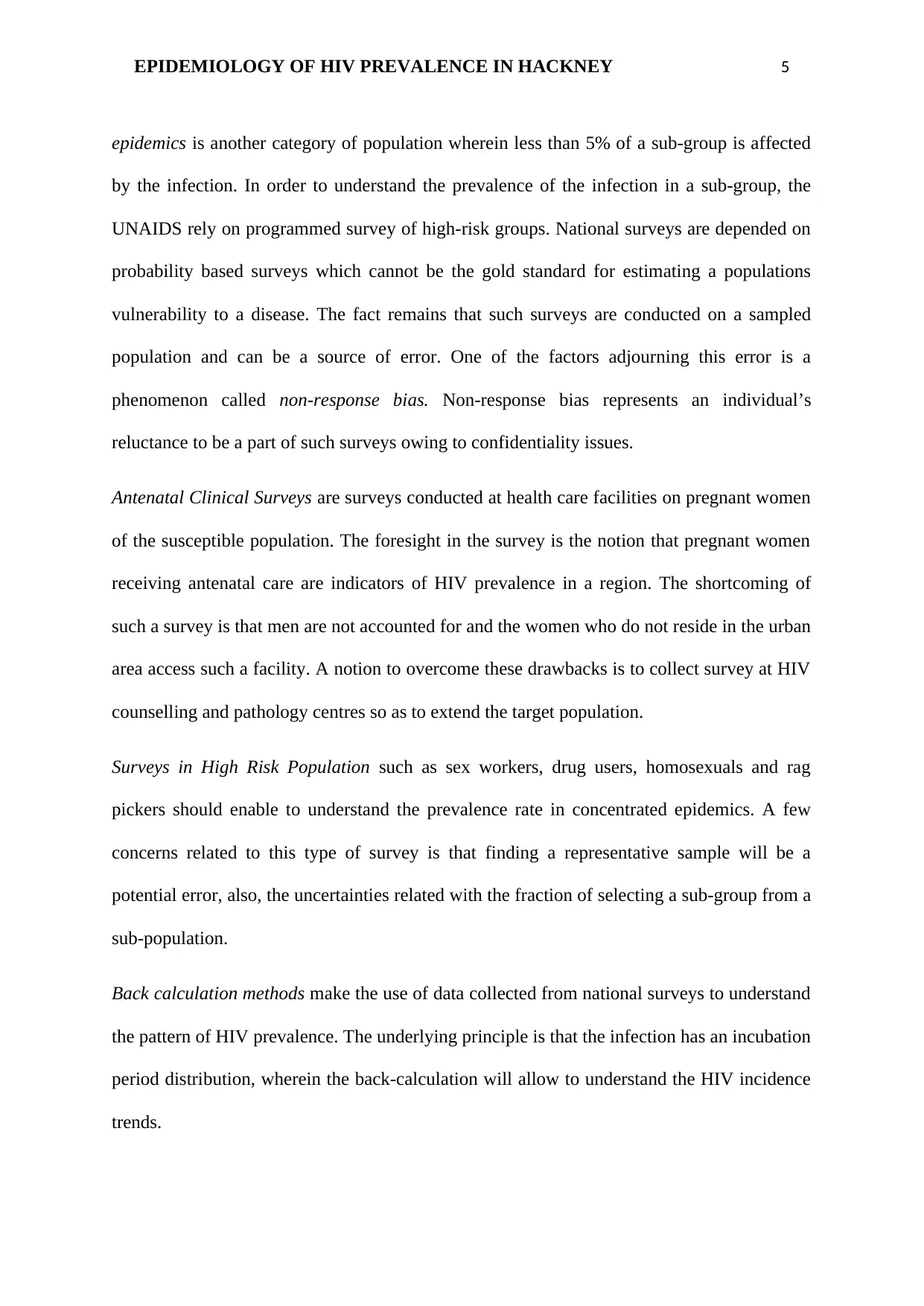
EPIDEMIOLOGY OF HIV PREVALENCE IN HACKNEY 5
epidemics is another category of population wherein less than 5% of a sub-group is affected
by the infection. In order to understand the prevalence of the infection in a sub-group, the
UNAIDS rely on programmed survey of high-risk groups. National surveys are depended on
probability based surveys which cannot be the gold standard for estimating a populations
vulnerability to a disease. The fact remains that such surveys are conducted on a sampled
population and can be a source of error. One of the factors adjourning this error is a
phenomenon called non-response bias. Non-response bias represents an individual’s
reluctance to be a part of such surveys owing to confidentiality issues.
Antenatal Clinical Surveys are surveys conducted at health care facilities on pregnant women
of the susceptible population. The foresight in the survey is the notion that pregnant women
receiving antenatal care are indicators of HIV prevalence in a region. The shortcoming of
such a survey is that men are not accounted for and the women who do not reside in the urban
area access such a facility. A notion to overcome these drawbacks is to collect survey at HIV
counselling and pathology centres so as to extend the target population.
Surveys in High Risk Population such as sex workers, drug users, homosexuals and rag
pickers should enable to understand the prevalence rate in concentrated epidemics. A few
concerns related to this type of survey is that finding a representative sample will be a
potential error, also, the uncertainties related with the fraction of selecting a sub-group from a
sub-population.
Back calculation methods make the use of data collected from national surveys to understand
the pattern of HIV prevalence. The underlying principle is that the infection has an incubation
period distribution, wherein the back-calculation will allow to understand the HIV incidence
trends.
epidemics is another category of population wherein less than 5% of a sub-group is affected
by the infection. In order to understand the prevalence of the infection in a sub-group, the
UNAIDS rely on programmed survey of high-risk groups. National surveys are depended on
probability based surveys which cannot be the gold standard for estimating a populations
vulnerability to a disease. The fact remains that such surveys are conducted on a sampled
population and can be a source of error. One of the factors adjourning this error is a
phenomenon called non-response bias. Non-response bias represents an individual’s
reluctance to be a part of such surveys owing to confidentiality issues.
Antenatal Clinical Surveys are surveys conducted at health care facilities on pregnant women
of the susceptible population. The foresight in the survey is the notion that pregnant women
receiving antenatal care are indicators of HIV prevalence in a region. The shortcoming of
such a survey is that men are not accounted for and the women who do not reside in the urban
area access such a facility. A notion to overcome these drawbacks is to collect survey at HIV
counselling and pathology centres so as to extend the target population.
Surveys in High Risk Population such as sex workers, drug users, homosexuals and rag
pickers should enable to understand the prevalence rate in concentrated epidemics. A few
concerns related to this type of survey is that finding a representative sample will be a
potential error, also, the uncertainties related with the fraction of selecting a sub-group from a
sub-population.
Back calculation methods make the use of data collected from national surveys to understand
the pattern of HIV prevalence. The underlying principle is that the infection has an incubation
period distribution, wherein the back-calculation will allow to understand the HIV incidence
trends.
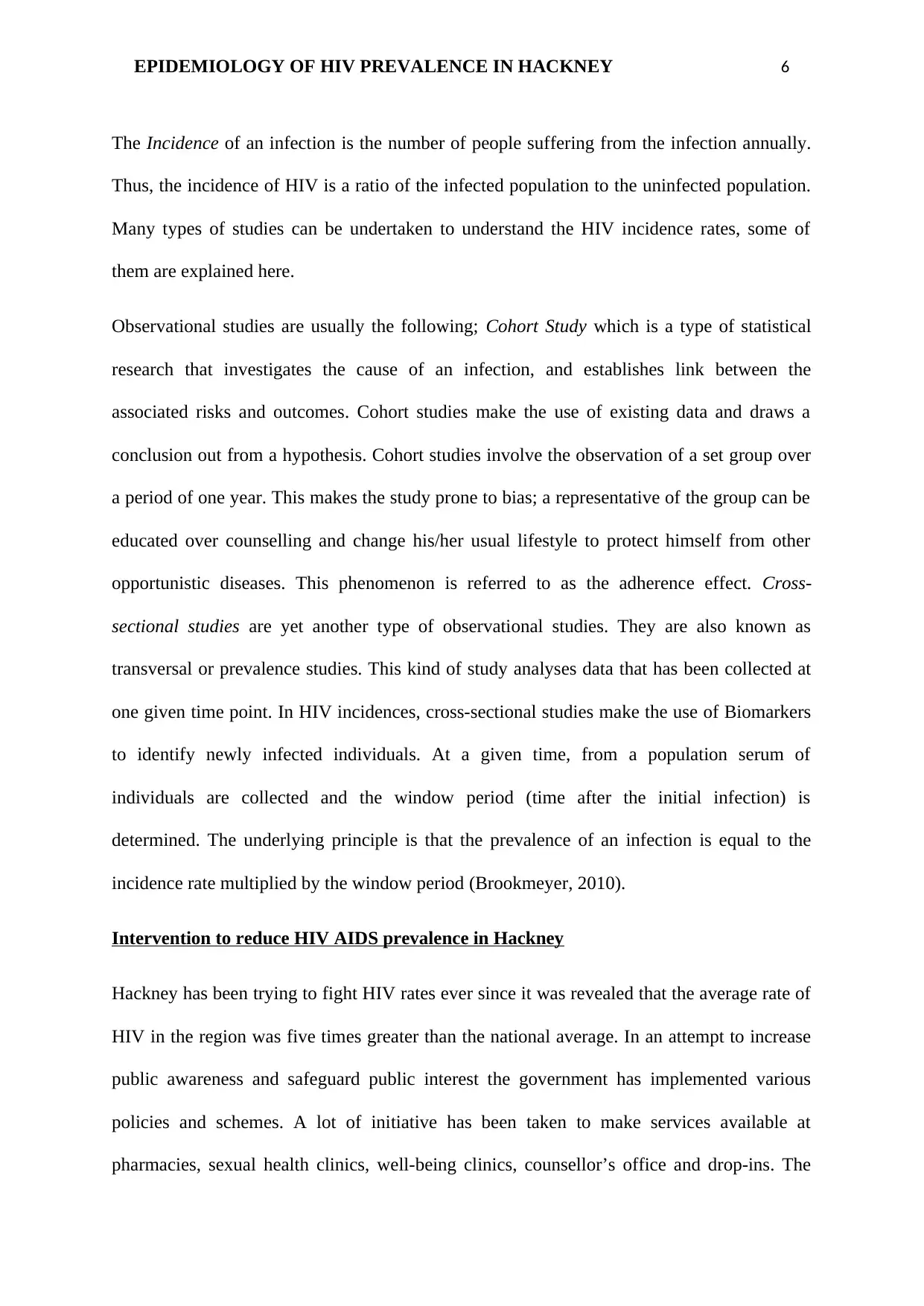
EPIDEMIOLOGY OF HIV PREVALENCE IN HACKNEY 6
The Incidence of an infection is the number of people suffering from the infection annually.
Thus, the incidence of HIV is a ratio of the infected population to the uninfected population.
Many types of studies can be undertaken to understand the HIV incidence rates, some of
them are explained here.
Observational studies are usually the following; Cohort Study which is a type of statistical
research that investigates the cause of an infection, and establishes link between the
associated risks and outcomes. Cohort studies make the use of existing data and draws a
conclusion out from a hypothesis. Cohort studies involve the observation of a set group over
a period of one year. This makes the study prone to bias; a representative of the group can be
educated over counselling and change his/her usual lifestyle to protect himself from other
opportunistic diseases. This phenomenon is referred to as the adherence effect. Cross-
sectional studies are yet another type of observational studies. They are also known as
transversal or prevalence studies. This kind of study analyses data that has been collected at
one given time point. In HIV incidences, cross-sectional studies make the use of Biomarkers
to identify newly infected individuals. At a given time, from a population serum of
individuals are collected and the window period (time after the initial infection) is
determined. The underlying principle is that the prevalence of an infection is equal to the
incidence rate multiplied by the window period (Brookmeyer, 2010).
Intervention to reduce HIV AIDS prevalence in Hackney
Hackney has been trying to fight HIV rates ever since it was revealed that the average rate of
HIV in the region was five times greater than the national average. In an attempt to increase
public awareness and safeguard public interest the government has implemented various
policies and schemes. A lot of initiative has been taken to make services available at
pharmacies, sexual health clinics, well-being clinics, counsellor’s office and drop-ins. The
The Incidence of an infection is the number of people suffering from the infection annually.
Thus, the incidence of HIV is a ratio of the infected population to the uninfected population.
Many types of studies can be undertaken to understand the HIV incidence rates, some of
them are explained here.
Observational studies are usually the following; Cohort Study which is a type of statistical
research that investigates the cause of an infection, and establishes link between the
associated risks and outcomes. Cohort studies make the use of existing data and draws a
conclusion out from a hypothesis. Cohort studies involve the observation of a set group over
a period of one year. This makes the study prone to bias; a representative of the group can be
educated over counselling and change his/her usual lifestyle to protect himself from other
opportunistic diseases. This phenomenon is referred to as the adherence effect. Cross-
sectional studies are yet another type of observational studies. They are also known as
transversal or prevalence studies. This kind of study analyses data that has been collected at
one given time point. In HIV incidences, cross-sectional studies make the use of Biomarkers
to identify newly infected individuals. At a given time, from a population serum of
individuals are collected and the window period (time after the initial infection) is
determined. The underlying principle is that the prevalence of an infection is equal to the
incidence rate multiplied by the window period (Brookmeyer, 2010).
Intervention to reduce HIV AIDS prevalence in Hackney
Hackney has been trying to fight HIV rates ever since it was revealed that the average rate of
HIV in the region was five times greater than the national average. In an attempt to increase
public awareness and safeguard public interest the government has implemented various
policies and schemes. A lot of initiative has been taken to make services available at
pharmacies, sexual health clinics, well-being clinics, counsellor’s office and drop-ins. The
⊘ This is a preview!⊘
Do you want full access?
Subscribe today to unlock all pages.

Trusted by 1+ million students worldwide
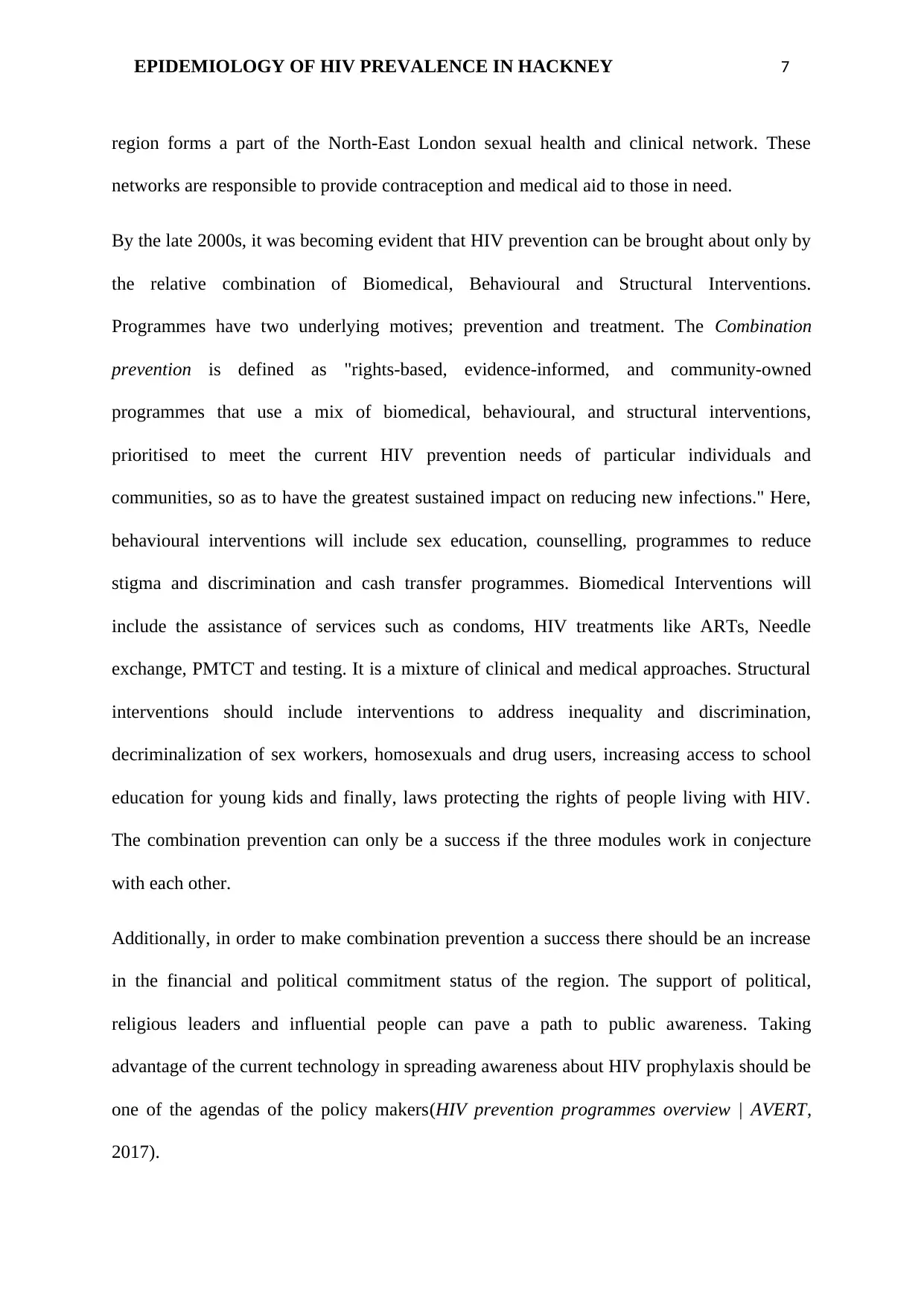
EPIDEMIOLOGY OF HIV PREVALENCE IN HACKNEY 7
region forms a part of the North-East London sexual health and clinical network. These
networks are responsible to provide contraception and medical aid to those in need.
By the late 2000s, it was becoming evident that HIV prevention can be brought about only by
the relative combination of Biomedical, Behavioural and Structural Interventions.
Programmes have two underlying motives; prevention and treatment. The Combination
prevention is defined as "rights-based, evidence-informed, and community-owned
programmes that use a mix of biomedical, behavioural, and structural interventions,
prioritised to meet the current HIV prevention needs of particular individuals and
communities, so as to have the greatest sustained impact on reducing new infections." Here,
behavioural interventions will include sex education, counselling, programmes to reduce
stigma and discrimination and cash transfer programmes. Biomedical Interventions will
include the assistance of services such as condoms, HIV treatments like ARTs, Needle
exchange, PMTCT and testing. It is a mixture of clinical and medical approaches. Structural
interventions should include interventions to address inequality and discrimination,
decriminalization of sex workers, homosexuals and drug users, increasing access to school
education for young kids and finally, laws protecting the rights of people living with HIV.
The combination prevention can only be a success if the three modules work in conjecture
with each other.
Additionally, in order to make combination prevention a success there should be an increase
in the financial and political commitment status of the region. The support of political,
religious leaders and influential people can pave a path to public awareness. Taking
advantage of the current technology in spreading awareness about HIV prophylaxis should be
one of the agendas of the policy makers(HIV prevention programmes overview | AVERT,
2017).
region forms a part of the North-East London sexual health and clinical network. These
networks are responsible to provide contraception and medical aid to those in need.
By the late 2000s, it was becoming evident that HIV prevention can be brought about only by
the relative combination of Biomedical, Behavioural and Structural Interventions.
Programmes have two underlying motives; prevention and treatment. The Combination
prevention is defined as "rights-based, evidence-informed, and community-owned
programmes that use a mix of biomedical, behavioural, and structural interventions,
prioritised to meet the current HIV prevention needs of particular individuals and
communities, so as to have the greatest sustained impact on reducing new infections." Here,
behavioural interventions will include sex education, counselling, programmes to reduce
stigma and discrimination and cash transfer programmes. Biomedical Interventions will
include the assistance of services such as condoms, HIV treatments like ARTs, Needle
exchange, PMTCT and testing. It is a mixture of clinical and medical approaches. Structural
interventions should include interventions to address inequality and discrimination,
decriminalization of sex workers, homosexuals and drug users, increasing access to school
education for young kids and finally, laws protecting the rights of people living with HIV.
The combination prevention can only be a success if the three modules work in conjecture
with each other.
Additionally, in order to make combination prevention a success there should be an increase
in the financial and political commitment status of the region. The support of political,
religious leaders and influential people can pave a path to public awareness. Taking
advantage of the current technology in spreading awareness about HIV prophylaxis should be
one of the agendas of the policy makers(HIV prevention programmes overview | AVERT,
2017).
Paraphrase This Document
Need a fresh take? Get an instant paraphrase of this document with our AI Paraphraser
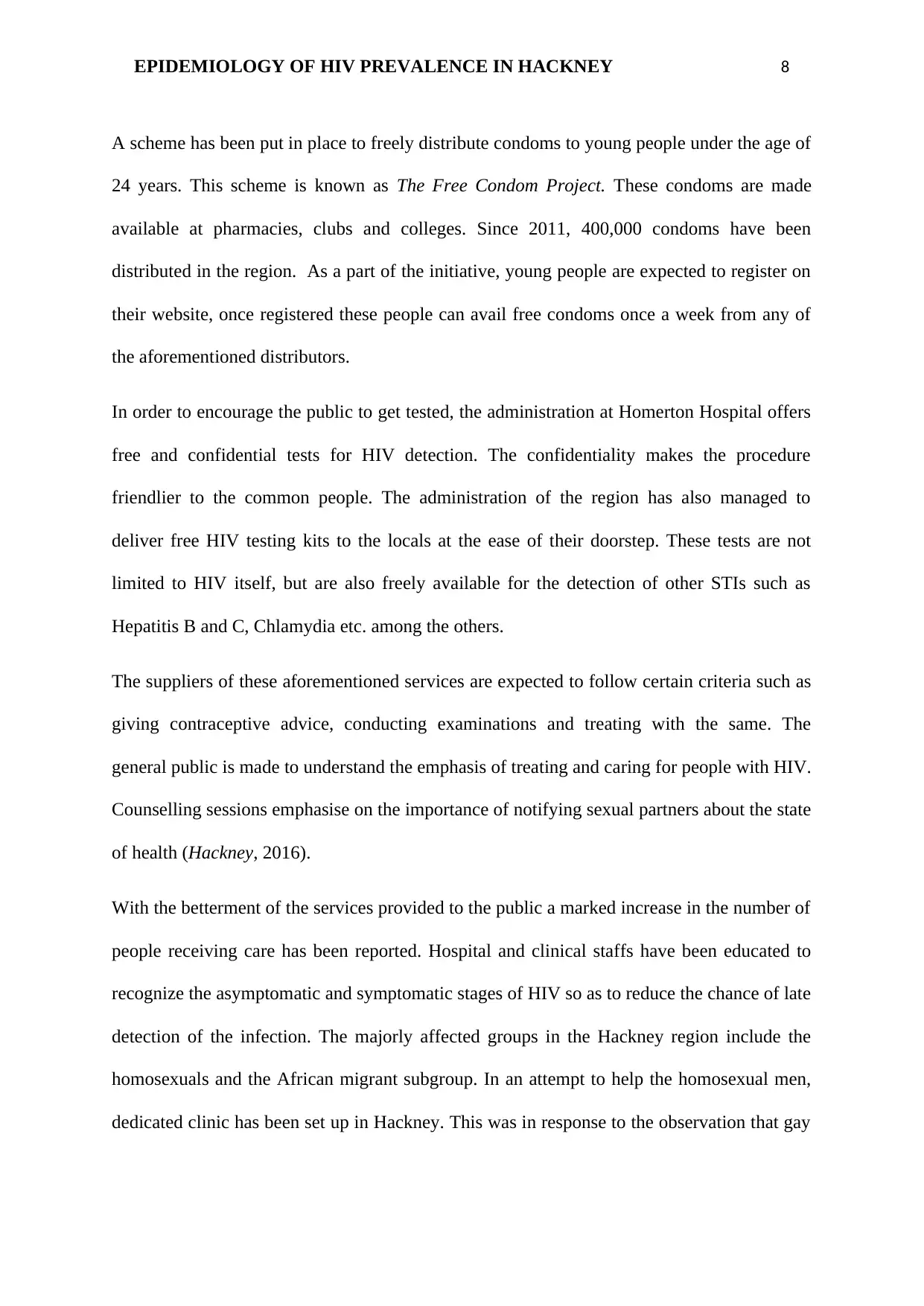
EPIDEMIOLOGY OF HIV PREVALENCE IN HACKNEY 8
A scheme has been put in place to freely distribute condoms to young people under the age of
24 years. This scheme is known as The Free Condom Project. These condoms are made
available at pharmacies, clubs and colleges. Since 2011, 400,000 condoms have been
distributed in the region. As a part of the initiative, young people are expected to register on
their website, once registered these people can avail free condoms once a week from any of
the aforementioned distributors.
In order to encourage the public to get tested, the administration at Homerton Hospital offers
free and confidential tests for HIV detection. The confidentiality makes the procedure
friendlier to the common people. The administration of the region has also managed to
deliver free HIV testing kits to the locals at the ease of their doorstep. These tests are not
limited to HIV itself, but are also freely available for the detection of other STIs such as
Hepatitis B and C, Chlamydia etc. among the others.
The suppliers of these aforementioned services are expected to follow certain criteria such as
giving contraceptive advice, conducting examinations and treating with the same. The
general public is made to understand the emphasis of treating and caring for people with HIV.
Counselling sessions emphasise on the importance of notifying sexual partners about the state
of health (Hackney, 2016).
With the betterment of the services provided to the public a marked increase in the number of
people receiving care has been reported. Hospital and clinical staffs have been educated to
recognize the asymptomatic and symptomatic stages of HIV so as to reduce the chance of late
detection of the infection. The majorly affected groups in the Hackney region include the
homosexuals and the African migrant subgroup. In an attempt to help the homosexual men,
dedicated clinic has been set up in Hackney. This was in response to the observation that gay
A scheme has been put in place to freely distribute condoms to young people under the age of
24 years. This scheme is known as The Free Condom Project. These condoms are made
available at pharmacies, clubs and colleges. Since 2011, 400,000 condoms have been
distributed in the region. As a part of the initiative, young people are expected to register on
their website, once registered these people can avail free condoms once a week from any of
the aforementioned distributors.
In order to encourage the public to get tested, the administration at Homerton Hospital offers
free and confidential tests for HIV detection. The confidentiality makes the procedure
friendlier to the common people. The administration of the region has also managed to
deliver free HIV testing kits to the locals at the ease of their doorstep. These tests are not
limited to HIV itself, but are also freely available for the detection of other STIs such as
Hepatitis B and C, Chlamydia etc. among the others.
The suppliers of these aforementioned services are expected to follow certain criteria such as
giving contraceptive advice, conducting examinations and treating with the same. The
general public is made to understand the emphasis of treating and caring for people with HIV.
Counselling sessions emphasise on the importance of notifying sexual partners about the state
of health (Hackney, 2016).
With the betterment of the services provided to the public a marked increase in the number of
people receiving care has been reported. Hospital and clinical staffs have been educated to
recognize the asymptomatic and symptomatic stages of HIV so as to reduce the chance of late
detection of the infection. The majorly affected groups in the Hackney region include the
homosexuals and the African migrant subgroup. In an attempt to help the homosexual men,
dedicated clinic has been set up in Hackney. This was in response to the observation that gay
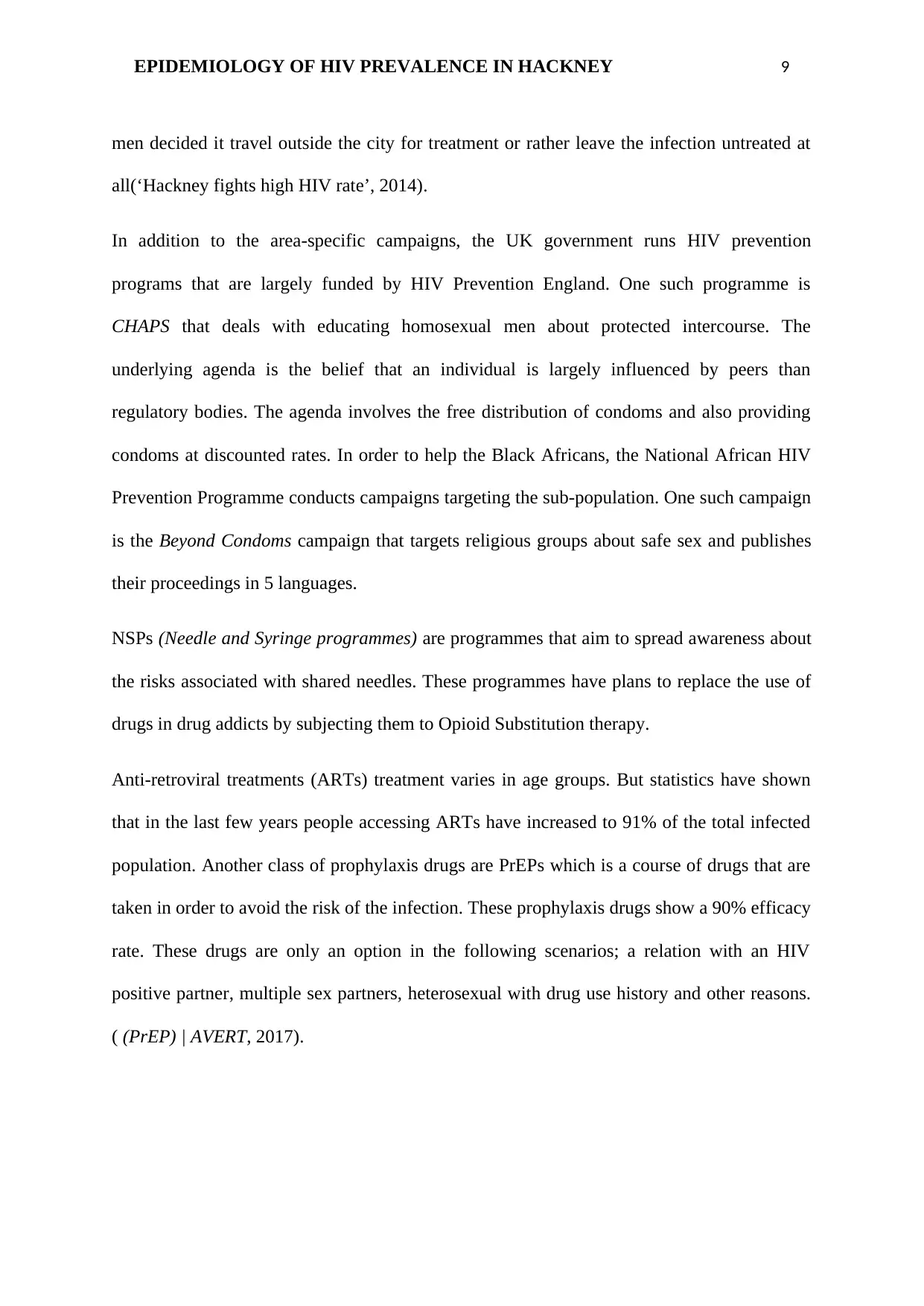
EPIDEMIOLOGY OF HIV PREVALENCE IN HACKNEY 9
men decided it travel outside the city for treatment or rather leave the infection untreated at
all(‘Hackney fights high HIV rate’, 2014).
In addition to the area-specific campaigns, the UK government runs HIV prevention
programs that are largely funded by HIV Prevention England. One such programme is
CHAPS that deals with educating homosexual men about protected intercourse. The
underlying agenda is the belief that an individual is largely influenced by peers than
regulatory bodies. The agenda involves the free distribution of condoms and also providing
condoms at discounted rates. In order to help the Black Africans, the National African HIV
Prevention Programme conducts campaigns targeting the sub-population. One such campaign
is the Beyond Condoms campaign that targets religious groups about safe sex and publishes
their proceedings in 5 languages.
NSPs (Needle and Syringe programmes) are programmes that aim to spread awareness about
the risks associated with shared needles. These programmes have plans to replace the use of
drugs in drug addicts by subjecting them to Opioid Substitution therapy.
Anti-retroviral treatments (ARTs) treatment varies in age groups. But statistics have shown
that in the last few years people accessing ARTs have increased to 91% of the total infected
population. Another class of prophylaxis drugs are PrEPs which is a course of drugs that are
taken in order to avoid the risk of the infection. These prophylaxis drugs show a 90% efficacy
rate. These drugs are only an option in the following scenarios; a relation with an HIV
positive partner, multiple sex partners, heterosexual with drug use history and other reasons.
( (PrEP) | AVERT, 2017).
men decided it travel outside the city for treatment or rather leave the infection untreated at
all(‘Hackney fights high HIV rate’, 2014).
In addition to the area-specific campaigns, the UK government runs HIV prevention
programs that are largely funded by HIV Prevention England. One such programme is
CHAPS that deals with educating homosexual men about protected intercourse. The
underlying agenda is the belief that an individual is largely influenced by peers than
regulatory bodies. The agenda involves the free distribution of condoms and also providing
condoms at discounted rates. In order to help the Black Africans, the National African HIV
Prevention Programme conducts campaigns targeting the sub-population. One such campaign
is the Beyond Condoms campaign that targets religious groups about safe sex and publishes
their proceedings in 5 languages.
NSPs (Needle and Syringe programmes) are programmes that aim to spread awareness about
the risks associated with shared needles. These programmes have plans to replace the use of
drugs in drug addicts by subjecting them to Opioid Substitution therapy.
Anti-retroviral treatments (ARTs) treatment varies in age groups. But statistics have shown
that in the last few years people accessing ARTs have increased to 91% of the total infected
population. Another class of prophylaxis drugs are PrEPs which is a course of drugs that are
taken in order to avoid the risk of the infection. These prophylaxis drugs show a 90% efficacy
rate. These drugs are only an option in the following scenarios; a relation with an HIV
positive partner, multiple sex partners, heterosexual with drug use history and other reasons.
( (PrEP) | AVERT, 2017).
⊘ This is a preview!⊘
Do you want full access?
Subscribe today to unlock all pages.

Trusted by 1+ million students worldwide
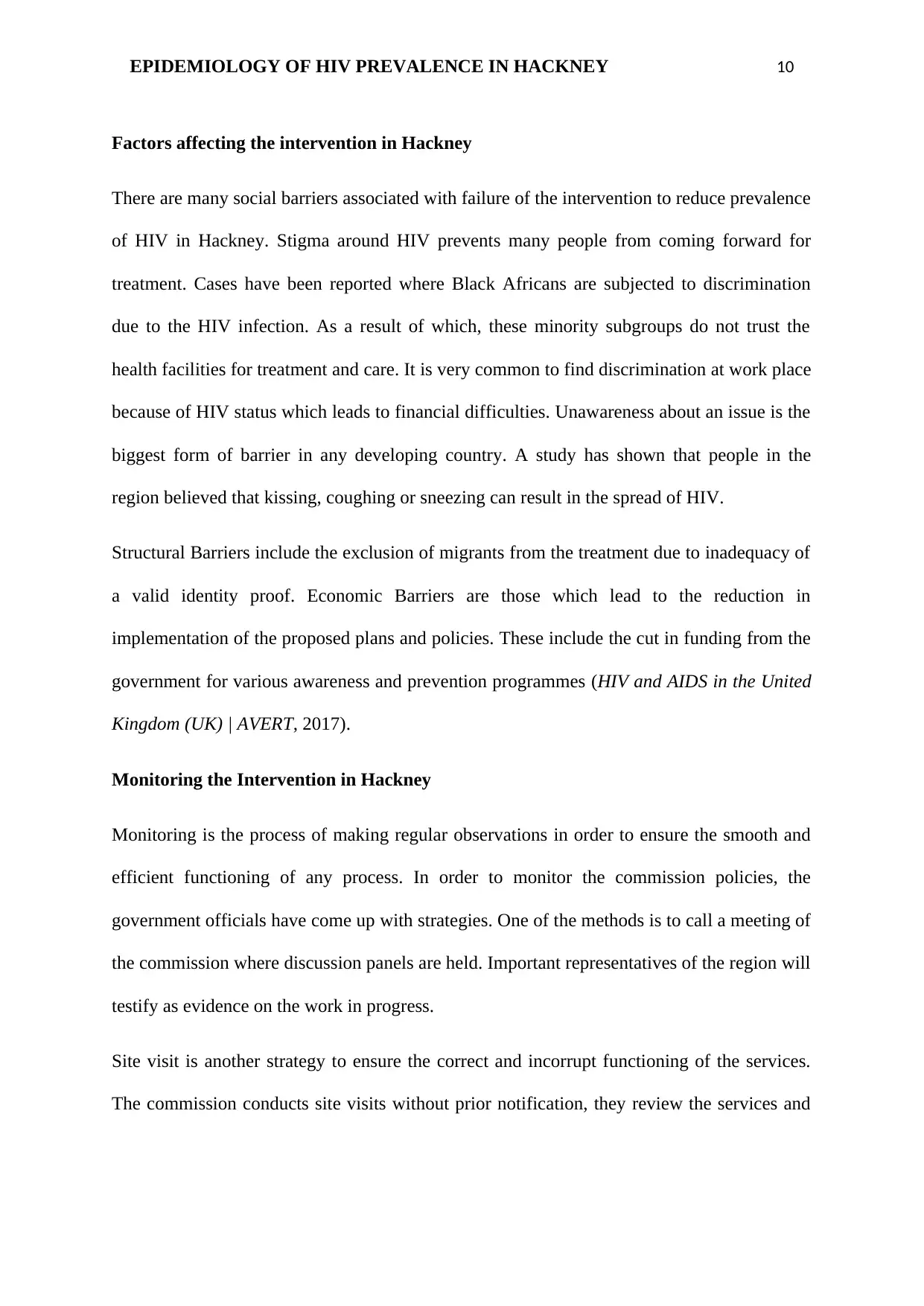
EPIDEMIOLOGY OF HIV PREVALENCE IN HACKNEY 10
Factors affecting the intervention in Hackney
There are many social barriers associated with failure of the intervention to reduce prevalence
of HIV in Hackney. Stigma around HIV prevents many people from coming forward for
treatment. Cases have been reported where Black Africans are subjected to discrimination
due to the HIV infection. As a result of which, these minority subgroups do not trust the
health facilities for treatment and care. It is very common to find discrimination at work place
because of HIV status which leads to financial difficulties. Unawareness about an issue is the
biggest form of barrier in any developing country. A study has shown that people in the
region believed that kissing, coughing or sneezing can result in the spread of HIV.
Structural Barriers include the exclusion of migrants from the treatment due to inadequacy of
a valid identity proof. Economic Barriers are those which lead to the reduction in
implementation of the proposed plans and policies. These include the cut in funding from the
government for various awareness and prevention programmes (HIV and AIDS in the United
Kingdom (UK) | AVERT, 2017).
Monitoring the Intervention in Hackney
Monitoring is the process of making regular observations in order to ensure the smooth and
efficient functioning of any process. In order to monitor the commission policies, the
government officials have come up with strategies. One of the methods is to call a meeting of
the commission where discussion panels are held. Important representatives of the region will
testify as evidence on the work in progress.
Site visit is another strategy to ensure the correct and incorrupt functioning of the services.
The commission conducts site visits without prior notification, they review the services and
Factors affecting the intervention in Hackney
There are many social barriers associated with failure of the intervention to reduce prevalence
of HIV in Hackney. Stigma around HIV prevents many people from coming forward for
treatment. Cases have been reported where Black Africans are subjected to discrimination
due to the HIV infection. As a result of which, these minority subgroups do not trust the
health facilities for treatment and care. It is very common to find discrimination at work place
because of HIV status which leads to financial difficulties. Unawareness about an issue is the
biggest form of barrier in any developing country. A study has shown that people in the
region believed that kissing, coughing or sneezing can result in the spread of HIV.
Structural Barriers include the exclusion of migrants from the treatment due to inadequacy of
a valid identity proof. Economic Barriers are those which lead to the reduction in
implementation of the proposed plans and policies. These include the cut in funding from the
government for various awareness and prevention programmes (HIV and AIDS in the United
Kingdom (UK) | AVERT, 2017).
Monitoring the Intervention in Hackney
Monitoring is the process of making regular observations in order to ensure the smooth and
efficient functioning of any process. In order to monitor the commission policies, the
government officials have come up with strategies. One of the methods is to call a meeting of
the commission where discussion panels are held. Important representatives of the region will
testify as evidence on the work in progress.
Site visit is another strategy to ensure the correct and incorrupt functioning of the services.
The commission conducts site visits without prior notification, they review the services and
Paraphrase This Document
Need a fresh take? Get an instant paraphrase of this document with our AI Paraphraser

EPIDEMIOLOGY OF HIV PREVALENCE IN HACKNEY 11
the members also get a chance to interact with the service users (‘Report of the health in
hackney scrutiny commission’, 2014).
Another body that is responsible to ensure the proper functioning of the policies and services
is the Scrutiny commission.
Conclusion
It is remarkable that treatment such as Antiretroviral treatments have grown in the past
decade in the region. However, the incidence rate of HIV AIDS infection has not reduced.
The best solution to tackle the problem is increased awareness by education, by providing
social support to the affected and by creating a foundation for action. The policies of the
government can be strengthened by allocating resources to NGOs and start-up service
providing ventures. Providing free condoms, rendering home and school based care will
prove helpful in the long run.
It is no doubt that the government plays the fundamental role in allocating funds for the
awareness and treatment drives, but the government should, in practise, work alongside small
ventures and NGOs that have a greater influence on the locals. Programmes that aim at
driving out poverty should also include the HIV awareness regimens. Lastly, it is necessary to
monitor the intervention to understand if it was a success or failure. Benchmarks should be
set and service providers should be held accountable for their actions. Only by adopting
newer policies and serious intervention monitoring can the prevalence rate of HIV in
Hackney be controlled.
the members also get a chance to interact with the service users (‘Report of the health in
hackney scrutiny commission’, 2014).
Another body that is responsible to ensure the proper functioning of the policies and services
is the Scrutiny commission.
Conclusion
It is remarkable that treatment such as Antiretroviral treatments have grown in the past
decade in the region. However, the incidence rate of HIV AIDS infection has not reduced.
The best solution to tackle the problem is increased awareness by education, by providing
social support to the affected and by creating a foundation for action. The policies of the
government can be strengthened by allocating resources to NGOs and start-up service
providing ventures. Providing free condoms, rendering home and school based care will
prove helpful in the long run.
It is no doubt that the government plays the fundamental role in allocating funds for the
awareness and treatment drives, but the government should, in practise, work alongside small
ventures and NGOs that have a greater influence on the locals. Programmes that aim at
driving out poverty should also include the HIV awareness regimens. Lastly, it is necessary to
monitor the intervention to understand if it was a success or failure. Benchmarks should be
set and service providers should be held accountable for their actions. Only by adopting
newer policies and serious intervention monitoring can the prevalence rate of HIV in
Hackney be controlled.
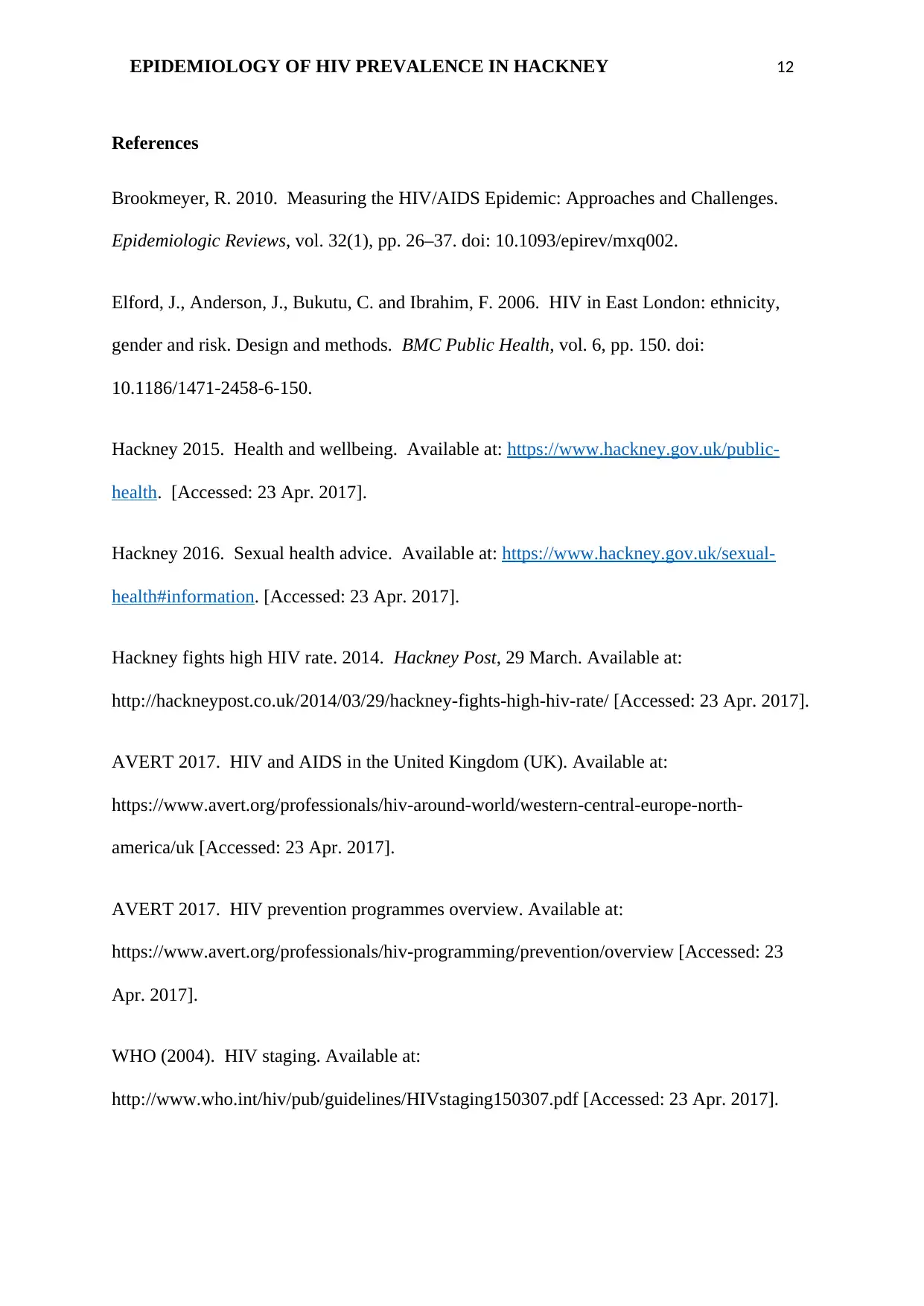
EPIDEMIOLOGY OF HIV PREVALENCE IN HACKNEY 12
References
Brookmeyer, R. 2010. Measuring the HIV/AIDS Epidemic: Approaches and Challenges.
Epidemiologic Reviews, vol. 32(1), pp. 26–37. doi: 10.1093/epirev/mxq002.
Elford, J., Anderson, J., Bukutu, C. and Ibrahim, F. 2006. HIV in East London: ethnicity,
gender and risk. Design and methods. BMC Public Health, vol. 6, pp. 150. doi:
10.1186/1471-2458-6-150.
Hackney 2015. Health and wellbeing. Available at: https://www.hackney.gov.uk/public-
health. [Accessed: 23 Apr. 2017].
Hackney 2016. Sexual health advice. Available at: https://www.hackney.gov.uk/sexual-
health#information. [Accessed: 23 Apr. 2017].
Hackney fights high HIV rate. 2014. Hackney Post, 29 March. Available at:
http://hackneypost.co.uk/2014/03/29/hackney-fights-high-hiv-rate/ [Accessed: 23 Apr. 2017].
AVERT 2017. HIV and AIDS in the United Kingdom (UK). Available at:
https://www.avert.org/professionals/hiv-around-world/western-central-europe-north-
america/uk [Accessed: 23 Apr. 2017].
AVERT 2017. HIV prevention programmes overview. Available at:
https://www.avert.org/professionals/hiv-programming/prevention/overview [Accessed: 23
Apr. 2017].
WHO (2004). HIV staging. Available at:
http://www.who.int/hiv/pub/guidelines/HIVstaging150307.pdf [Accessed: 23 Apr. 2017].
References
Brookmeyer, R. 2010. Measuring the HIV/AIDS Epidemic: Approaches and Challenges.
Epidemiologic Reviews, vol. 32(1), pp. 26–37. doi: 10.1093/epirev/mxq002.
Elford, J., Anderson, J., Bukutu, C. and Ibrahim, F. 2006. HIV in East London: ethnicity,
gender and risk. Design and methods. BMC Public Health, vol. 6, pp. 150. doi:
10.1186/1471-2458-6-150.
Hackney 2015. Health and wellbeing. Available at: https://www.hackney.gov.uk/public-
health. [Accessed: 23 Apr. 2017].
Hackney 2016. Sexual health advice. Available at: https://www.hackney.gov.uk/sexual-
health#information. [Accessed: 23 Apr. 2017].
Hackney fights high HIV rate. 2014. Hackney Post, 29 March. Available at:
http://hackneypost.co.uk/2014/03/29/hackney-fights-high-hiv-rate/ [Accessed: 23 Apr. 2017].
AVERT 2017. HIV and AIDS in the United Kingdom (UK). Available at:
https://www.avert.org/professionals/hiv-around-world/western-central-europe-north-
america/uk [Accessed: 23 Apr. 2017].
AVERT 2017. HIV prevention programmes overview. Available at:
https://www.avert.org/professionals/hiv-programming/prevention/overview [Accessed: 23
Apr. 2017].
WHO (2004). HIV staging. Available at:
http://www.who.int/hiv/pub/guidelines/HIVstaging150307.pdf [Accessed: 23 Apr. 2017].
⊘ This is a preview!⊘
Do you want full access?
Subscribe today to unlock all pages.

Trusted by 1+ million students worldwide
1 out of 13
Related Documents
Your All-in-One AI-Powered Toolkit for Academic Success.
+13062052269
info@desklib.com
Available 24*7 on WhatsApp / Email
![[object Object]](/_next/static/media/star-bottom.7253800d.svg)
Unlock your academic potential
Copyright © 2020–2026 A2Z Services. All Rights Reserved. Developed and managed by ZUCOL.





